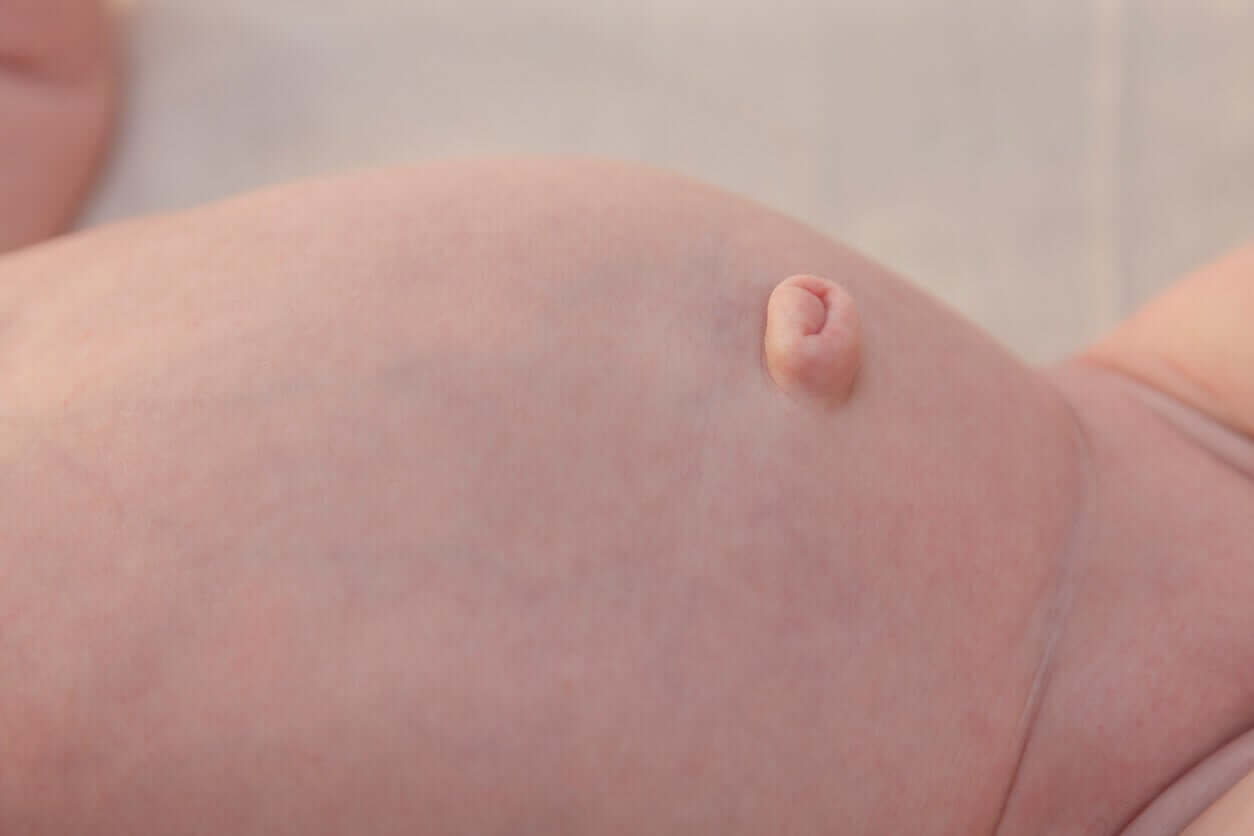Hirschsprung's Disease in Children: What Does It Consist Of?

Although many parents aren’t aware of it, Hirschsprung’s disease is a very common cause of intestinal obstruction in babies. According to estimates, 1 in 5,000 newborns suffers from it globally and diagnosis rarely takes place during pregnancy.
Next, we’ll tell you what it’s about and what its outstanding manifestations are. Keep reading!
What is Hirschsprung’s disease?
Hirschsprung’s disease is a congenital bowel disease that causes difficulties in defecation.
In this illness, there’s a type of obstruction to the digestive transit that’s known as functional. This means that there’s no physical (mechanical) obstacle blocking the stool. However, the walls of the intestine don’t work well enough to favor its exit to the outside.
In general, the intestinal portion that this disease affects most frequently is the rectus sigmoid (75 to 80% of cases), although the damage can extend to other parts of the colon and even affect it in its entirety (5 to 7% of cases).
You might be interested in: Intussusception in Babies: What Is It?
Why does it occur?
Hirschsprung’s disease occurs as a consequence of a defect in the migration process of neurons that connect the nervous system with the intestine. As a result, the neural network that usually forms around the walls of the colon doesn’t develop well and, therefore, doesn’t perform its functions properly either.
These nerves are essential in order to synchronize the movement of the digestive organs, called peristalsis.
If any of them fail to receive the proper signal, the intestinal walls contract in a disorganized way or don’t contract at all. Consequently, stool can’t be evacuated through the anus.
Causes of Hirschsprung’s disease
Most of the time, this disease occurs in isolation. However, in 30% of cases, it has to do with genetic diseases.
The main cause that determines its appearance is unknown, although experts recognize that it arises from the combination of several factors. Among them, the following stand out:
- Adverse uterine environment
- Male fetus (it’s 4 to 10 times more common in men than in women)
- Mutations in specific genes, such as the RET gene.
How does this disease manifest itself?

The detection of Hirschsprung’s usually takes place early in life, but the time of diagnosis depends on the extent of the defect.
In general, there are three types of clinical presentations:
- Distal bowel obstruction, typically in newborns
- Constipation or chronic constipation, in older children
- Enterocolitis.
Intestinal obstruction
In the first case, the most characteristic sign is the lack of elimination of meconium within the first 48 hours of life. Over time, the newborn also manifests irritability, refusal to feed, distention of the abdomen, and bilious (dark green) or fecaloid (brown and foul-smelling) vomiting.
Chronic constipation
When it comes to older children (or young adults), the main symptom is chronic constipation, which begins after the introduction of semisolids (6 months). Being a common childhood problem, the disease often goes unnoticed for several years.
However, it should always be suspected if constipation is accompanied by marked abdominal distention, frequent need for bowel enemas, and poor weight gain, among others.
Enterocolitis
Paradoxically, 10% of children can manifest the disease with abdominal pain, fever, and diarrhea (enterocolitis). In general, these are episodes that occur frequently and not by chance, as occurs in seasonal outbreaks. And, with directed questioning, the antecedent of the delay in the elimination of meconium at birth is verified.
How do doctors reach the definitive diagnosis of this disease?
When the pediatrician suspects this disease, they must carry out certain complementary tests and request an evaluation by a team of specialists.
Among the studies carried out in these cases, we can mention the following:
- Abdominal X-ray: Offers indirect signs of blockage of intestinal transit
- Barium contrast studies (or barium enema): Locate the site of obstruction
- Rectal manometry: Determines the pressure inside the rectum
- Bowel biopsy: Allows doctors to confirm the defect of the intestinal nerve cells
The treatment of Hirschsprung’s disease
At this time, the treatment of Hirschsprung’s disease is surgical. This can be done in one or two instances, depending on the age, the child’s health, the extent of the defect, and the experience of the surgeon.
The objective of the first intervention (or first surgical stage) is to release the contained fecal matter through a new exit orifice: An ostomy.
At the same time, the second intervention seeks to unite the part of the healthy colon with the rectum, by removing the diseased segment located between them. In other words, an attempt is made to create an intestinal bridge so that the fecal matter can finally exit through the anus. What’s more, in this same procedure, the ostomy is closed.
In any case, in those cases in which the compromise is minimal and the only symptom is constipation, the team of experts can indicate expectant behavior: Observe the evolution and indicate treatment with laxatives and a diet rich in fiber.

Is it possible to lead a normal life after surgery?
After surgery, there’s a very high risk of certain health complications. Among the most frequent, we can mention the following:
- Severe enterocolitis
- Chronic malnutrition
- Constipation
- Fecal or urinary incontinence
- Narrowing of the new junction between the healthy intestine and the rectum
Despite this, with proper medical follow-up, most children can overcome the difficulties of this disease. Leading a normal life is possible and, in general, the future prognosis is very encouraging.
Although many parents aren’t aware of it, Hirschsprung’s disease is a very common cause of intestinal obstruction in babies. According to estimates, 1 in 5,000 newborns suffers from it globally and diagnosis rarely takes place during pregnancy.
Next, we’ll tell you what it’s about and what its outstanding manifestations are. Keep reading!
What is Hirschsprung’s disease?
Hirschsprung’s disease is a congenital bowel disease that causes difficulties in defecation.
In this illness, there’s a type of obstruction to the digestive transit that’s known as functional. This means that there’s no physical (mechanical) obstacle blocking the stool. However, the walls of the intestine don’t work well enough to favor its exit to the outside.
In general, the intestinal portion that this disease affects most frequently is the rectus sigmoid (75 to 80% of cases), although the damage can extend to other parts of the colon and even affect it in its entirety (5 to 7% of cases).
You might be interested in: Intussusception in Babies: What Is It?
Why does it occur?
Hirschsprung’s disease occurs as a consequence of a defect in the migration process of neurons that connect the nervous system with the intestine. As a result, the neural network that usually forms around the walls of the colon doesn’t develop well and, therefore, doesn’t perform its functions properly either.
These nerves are essential in order to synchronize the movement of the digestive organs, called peristalsis.
If any of them fail to receive the proper signal, the intestinal walls contract in a disorganized way or don’t contract at all. Consequently, stool can’t be evacuated through the anus.
Causes of Hirschsprung’s disease
Most of the time, this disease occurs in isolation. However, in 30% of cases, it has to do with genetic diseases.
The main cause that determines its appearance is unknown, although experts recognize that it arises from the combination of several factors. Among them, the following stand out:
- Adverse uterine environment
- Male fetus (it’s 4 to 10 times more common in men than in women)
- Mutations in specific genes, such as the RET gene.
How does this disease manifest itself?

The detection of Hirschsprung’s usually takes place early in life, but the time of diagnosis depends on the extent of the defect.
In general, there are three types of clinical presentations:
- Distal bowel obstruction, typically in newborns
- Constipation or chronic constipation, in older children
- Enterocolitis.
Intestinal obstruction
In the first case, the most characteristic sign is the lack of elimination of meconium within the first 48 hours of life. Over time, the newborn also manifests irritability, refusal to feed, distention of the abdomen, and bilious (dark green) or fecaloid (brown and foul-smelling) vomiting.
Chronic constipation
When it comes to older children (or young adults), the main symptom is chronic constipation, which begins after the introduction of semisolids (6 months). Being a common childhood problem, the disease often goes unnoticed for several years.
However, it should always be suspected if constipation is accompanied by marked abdominal distention, frequent need for bowel enemas, and poor weight gain, among others.
Enterocolitis
Paradoxically, 10% of children can manifest the disease with abdominal pain, fever, and diarrhea (enterocolitis). In general, these are episodes that occur frequently and not by chance, as occurs in seasonal outbreaks. And, with directed questioning, the antecedent of the delay in the elimination of meconium at birth is verified.
How do doctors reach the definitive diagnosis of this disease?
When the pediatrician suspects this disease, they must carry out certain complementary tests and request an evaluation by a team of specialists.
Among the studies carried out in these cases, we can mention the following:
- Abdominal X-ray: Offers indirect signs of blockage of intestinal transit
- Barium contrast studies (or barium enema): Locate the site of obstruction
- Rectal manometry: Determines the pressure inside the rectum
- Bowel biopsy: Allows doctors to confirm the defect of the intestinal nerve cells
The treatment of Hirschsprung’s disease
At this time, the treatment of Hirschsprung’s disease is surgical. This can be done in one or two instances, depending on the age, the child’s health, the extent of the defect, and the experience of the surgeon.
The objective of the first intervention (or first surgical stage) is to release the contained fecal matter through a new exit orifice: An ostomy.
At the same time, the second intervention seeks to unite the part of the healthy colon with the rectum, by removing the diseased segment located between them. In other words, an attempt is made to create an intestinal bridge so that the fecal matter can finally exit through the anus. What’s more, in this same procedure, the ostomy is closed.
In any case, in those cases in which the compromise is minimal and the only symptom is constipation, the team of experts can indicate expectant behavior: Observe the evolution and indicate treatment with laxatives and a diet rich in fiber.

Is it possible to lead a normal life after surgery?
After surgery, there’s a very high risk of certain health complications. Among the most frequent, we can mention the following:
- Severe enterocolitis
- Chronic malnutrition
- Constipation
- Fecal or urinary incontinence
- Narrowing of the new junction between the healthy intestine and the rectum
Despite this, with proper medical follow-up, most children can overcome the difficulties of this disease. Leading a normal life is possible and, in general, the future prognosis is very encouraging.
All cited sources were thoroughly reviewed by our team to ensure their quality, reliability, currency, and validity. The bibliography of this article was considered reliable and of academic or scientific accuracy.
- Casillas Guzmín G. Anatomía y fisiología del intestino delgado Capítulo 26. En: Pérez Torres E, Abdo Francis JM, Bernal Sahagún F, Kershenobich Stalnikowitz D. Gastroenterología. México: McGraw-Hill, 2012. Disponible en: https://accessmedicina.mhmedical.com/content.aspx?bookid=1475§ionid=101522301
- de Manueles Jiménez J, de la Rubia Fernández L. Enfermedad de Hirschsprung. Protocolos diagnóstico-terapéuticos de Gastroenterología, Hepatología y Nutrición Pediátrica SEGHNP-AEP. [Internet] Disponible en: https://www.aeped.es/sites/default/files/documentos/Hirschsprung.pdf
- Langer JC. Hirschsprung disease. Curr Opin Pediatr. 2013 Jun;25(3):368-74. doi: 10.1097/MOP.0b013e328360c2a0. PMID: 23615177. Disponible en: https://pubmed.ncbi.nlm.nih.gov/23615177/
- Das K, Mohanty S. Hirschsprung Disease – Current Diagnosis and Management. Indian J Pediatr. 2017 Aug;84(8):618-623. doi: 10.1007/s12098-017-2371-8. Epub 2017 Jun 10. PMID: 28600660. Disponible en: https://pubmed.ncbi.nlm.nih.gov/28600660/
- Lorente-Rosa M, Andrés A, Sánchez-Galán A, et al. Nuevas mutaciones asociadas a la enfermedad de Hirschsprung. An Pediatr (Barc) 2020;93(4):222-227. Disponible en: https://doi.org/10.1016/j.anpedi.2019.05.019
This text is provided for informational purposes only and does not replace consultation with a professional. If in doubt, consult your specialist.








